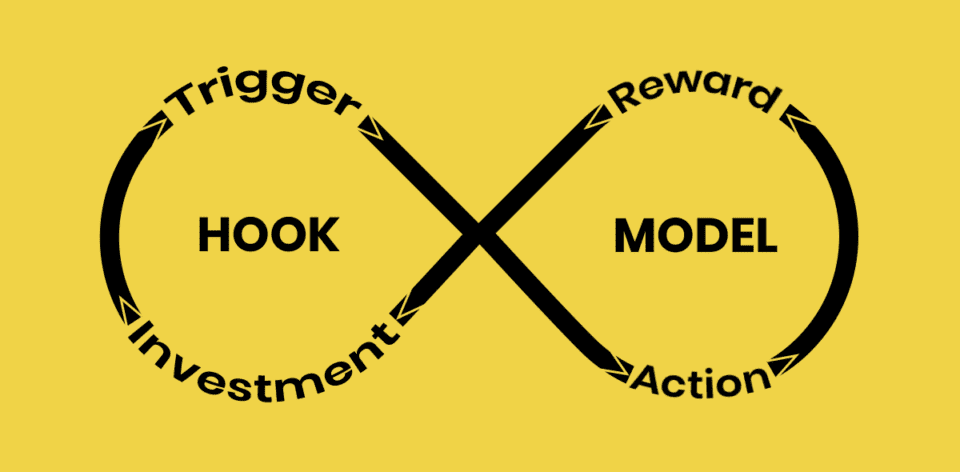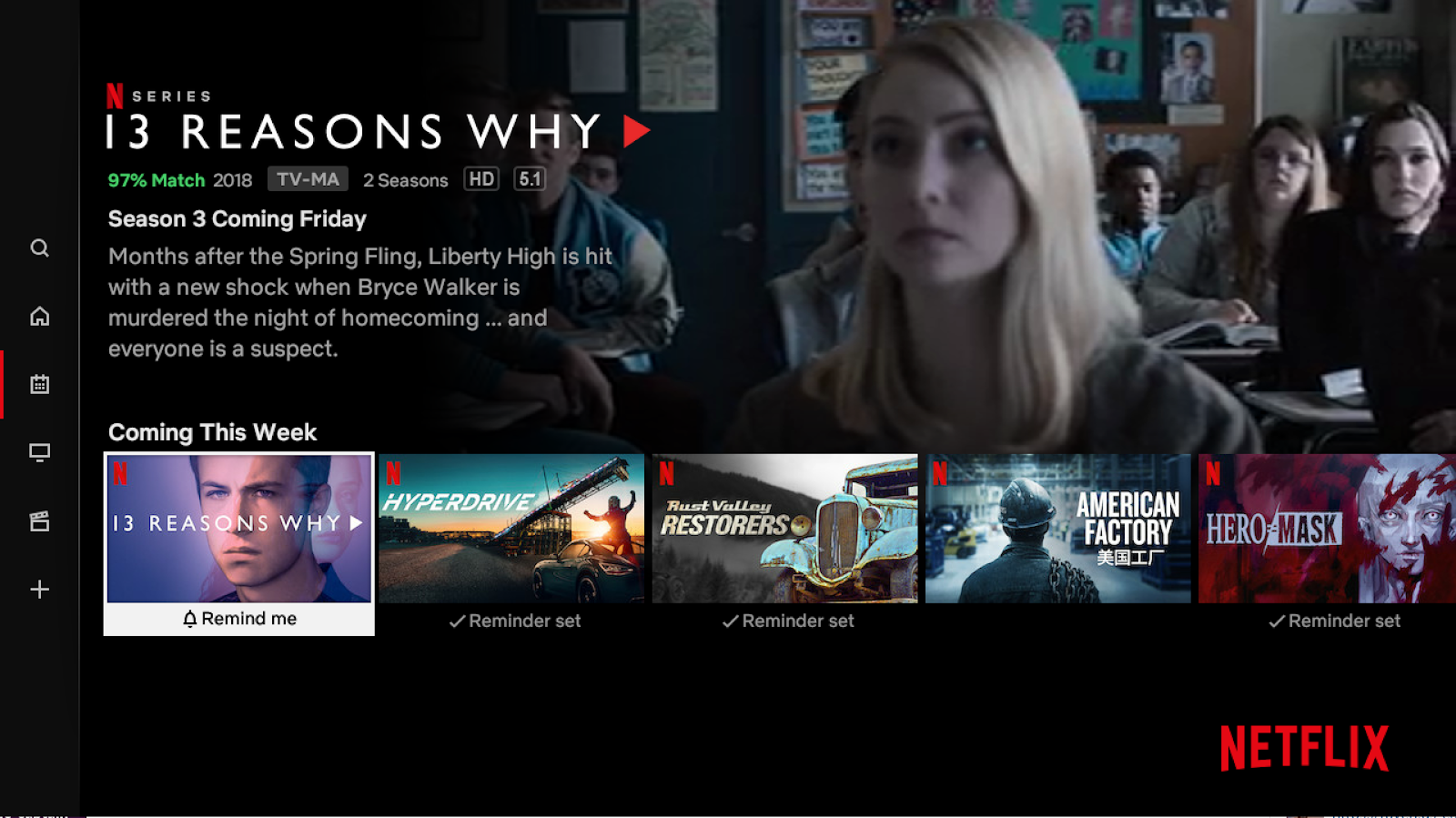We often talk about many reasons for customers to buy a product, such as the product has outstanding features, has a cheap price or interesting marketing,… However, in reality, there is a reason that is stronger than all of the above reasons: Habit. When a habit of consuming a product arises in people’s lives, they will make a purchase decision unconsciously and quickly, without even comparing price or quality with other brands. So how can a new brand create a habit of using the product for consumers? In today’s article, MarkKnow will introduce to readers the Hook Model – a formula to help brands make products part of consumers’ habits!
In 2008, Nir Eyal, a behavioral economist who graduated from Stanford University, and his friends started an advertising company on social media platforms. Here, Nir Eyal began to pay attention to consumer behavior in their purchasing decision process. He tried to study a series of successful products and companies at that time and realized a common feature that consumers are very much influenced by Habits .
From this psychological characteristic, Nir Eyal found a tool called – Hook Model – a marketing model that helps brands create product usage habits for consumers. The Hook Model was presented by Nir Eyal in his 2014 book “Hooked: How to Build Habit-Forming Products” and has been applied by many B2C brands from various fields and industries in their marketing activities.
Hook Model: The Formula for Creating User Habits
The Hook model, also known as the hook model, is a process used to create a habit of using a product in customers, thereby helping brands retain customers in the long term. When successfully applying the Hook model, customers will gradually shift from using the product based on external influences (brand advertising, people’s advice) to using it because of unconscious influences from within their thoughts, as a form of emotion.
At that time, the brand does not even need to spend millions of dollars on advertising or communication because users will automatically think of and return to buy your products as a habit when they have a need. Thereby increasing the lifetime value of customers (LTV), building a loyal customer base and saving marketing costs in the long term.
The Hook model consists of four steps:
- Trigger
- Action
- Variable Reward
- Investment
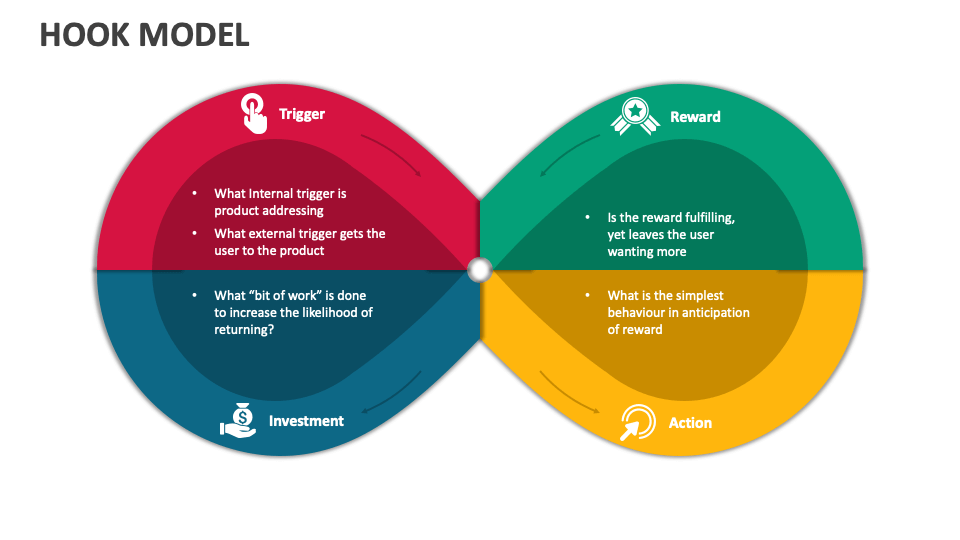
Trigger – Stimulate Demand
The first step of the Hook model is to trigger the customer’s initial need, which drives subsequent behaviors. There are two main types of triggers, including: Internal Triggers and External Triggers:
- External Activation is the use of external agents that affect consumer psychology such as: Email , Advertising, Messages or Word of Mouth Marketing, etc. The purpose of these external agents is to stimulate the following internal agents.
- Internal Triggers are the use of internal factors in the human mind and emotions. It can be memories inside the mind such as an old movie, an old song, an old family scene, etc. It can also be feelings of anxiety and fear such as the fear of getting sick, the feeling of fomo, etc. When linking external factors with the existing emotions and memories of a consumer, it will create a separate reason for them to use the product.
For example: Your brand produces a pharmaceutical product to prevent strokes in the elderly. You constantly publish advertisements and articles about the serious effects of strokes and the signs of strokes in the elderly such as headaches, vision loss, dizziness, etc. These are also obvious signs in the elderly, and when they hear that information, the fear of having a stroke will be formed. From here, the need to find treatment solutions will arise from customers.
Action – Promote Action
Actions here are used to describe user interactions with the brand. For example, searching for information about a product on Google, finding a product, selecting an item to add to the cart, paying on e-commerce platforms, etc.
After triggering the need, to make the user take action, two more factors are still needed: User’s Motivation and Ability to perform.
When it comes to motivation, there will always be three core types of motivation that influence human behavior:
1. Pleasure or Pain: For example, pain relief products like massage chairs are often promoted based on helping consumers avoid pain and discomfort.
2. Expectations or Fears: For example, advertising for healthcare brands often taps into customers’ feelings of anxiety about illness.
3. Social Acceptance or Social Rejection: For example, fragrance brands often emphasize being stigmatized and shunned by people because of body odor.
However, motivation alone is not enough to create action. An action will occur when two factors are ensured: Customer Motivation and Ability to Perform. The more difficult the activity is, the higher the level of motivation that the user needs to have to continue and complete that activity. On the contrary, if there is not too much motivation, your action must be simplified, optimizing the smoothest customer experience. To balance these two factors, you can use Fogg’s behavioral model below:
Random & Surprise Rewards
People love surprises even if they are not as valuable as the planned rewards. So offering different rewards at different times can stimulate the happy dopamine in customers, making them feel more excited. In addition, knowing that the brand always has surprise rewards, consumers will tend to come back and want to receive it again in the future.
When considering consumer rewards, keep in mind that rewards are not just physical gifts. There are emotional rewards that can have a stronger impact on customers’ emotions than physical ones. Therefore, brands need to remember that there are three types of rewards that can be used to motivate consumers:
- Social Rewards: One of the most basic human needs is to be accepted, respected, recognized, loved and honored by society. For example, the feeling of being honored, honored when winning a certain game, or simply being included in a certain community.
- Rewards for User Efforts: This is the part that is given to consumers after they have made certain efforts, for example, special vouchers for those who have worked hard to stay up late to “hunt” for vouchers.
- Personal Rewards or Self-Satisfaction: Humans love control, which is why we often check off our to-do lists and goals. So to stimulate consumer self-satisfaction, give them control over some of their interactions with the brand. For example, tracking their order journey, tracking payment progress, or tracking the tasks they have completed when participating in the brand’s game, etc. Or simply recognition for the goals they have completed, for example, upgrading their loyalty status from silver to gold.
Investment – Call for Investment
In the final stage, the brand needs to ask users to “invest” in the product, of course not in material terms like their partners. This investment is expressed in the form of time, data, effort, application registration fees, etc. This investment makes users feel that they have contributed to the product, making the product more valuable to them. On the other hand, the higher the investment level, whether in time or money, the higher the switching cost in the user’s mind, making it more difficult to leave the product.
In addition, this action also helps improve services and improve products and services according to user needs, thereby increasing their ability to return in the future. And makes users realize that they are important in the eyes of the brand.
Repeat the above pattern sequence:
Just going through the above cycle is not enough. For a habit to take root, the user needs to go through this cycle many times, experiencing successive actions and satisfying emotions.
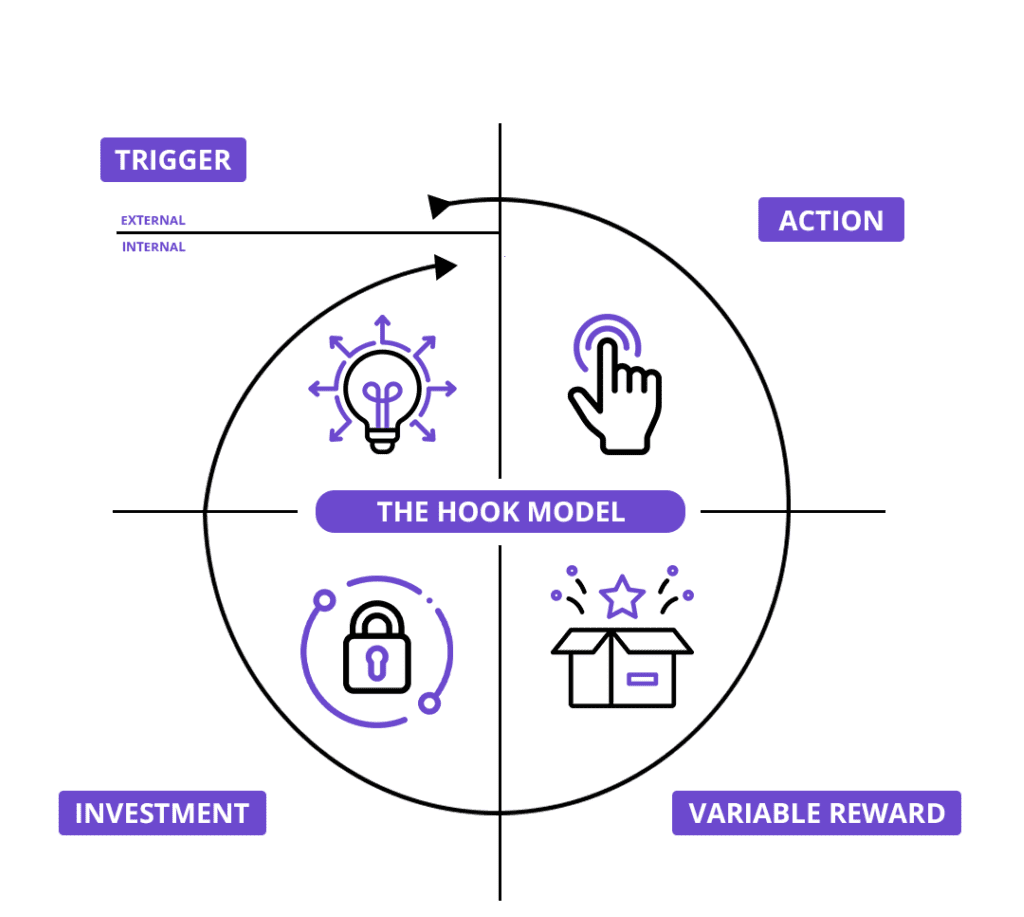
Hook Model Examples from Major Brands
#1: Netflix
Activate :
Netflix is a master of tapping into both external and internal drivers of customer demand.
- For External Agents: Netflix has a personalized notification system for each customer: Notification of new seasons, new episodes of your favorite movies, Notification of hot movies for viewers of the same age, Notification of a suitable movie for the weekend, to relax after a day of work,…
- For Internal Triggers: Netflix also cleverly taps into emotions that are easily felt in viewers’ everyday lives, such as boredom or the desire to relax after a long day. From there, the brand positions its service as a solution to viewers’ internal emotions.
Act:
- About Motivation: Netflix shows the trailer right when the user just touches a movie on the interface, making the user attracted from that moment. Shows the movies that the user is watching, making the user quickly want to finish those movies.
- About the Capabilities: The interface is easy to use and offers unique options. Users can continue watching a movie that has already started, choose a new movie, or let the AI choose a movie for them.
Reward Changes:
- The Social Reward is that you will be joining a discussion group about the movie you just watched, a fan community of the series you love.
- Reward Yourself: Allows you to track your viewing progress for each movie, giving you the satisfaction of watching an entire season in one sitting.
Invest:
Netflix encourages users to invest time with features like:
- Displays the movies you’ve watched, creating a collection that leaves you wanting more.
- The autoplay feature “Next episode in 10 seconds” keeps viewers hooked for hours on end.
- Show previews of the next episode with interesting images and content that keep viewers hooked.
And from there, the more time you invest in Netflix, the harder it becomes to leave the platform.
By applying the Hooked Model, Netflix has created a loop of viewing for its users. The more you watch, the more accurately Netflix recommends content you’ll enjoy, keeping you coming back for more. This leads to higher engagement, increased user retention, and stronger brand loyalty.
#2: Duolingo
Activate :
- For External Agents: Duolingo will constantly remind you to take a quick lesson via email and personalized notifications based on your learning path. The brand even appears across social media channels, in every corner where users can appear to remind them to study.
- For Internal Agents: Duolingo is very good at stimulating users’ internal psychology: Warning users that they will lose their streak, Stimulating their regret when they miss lessons, etc.
Act:
- About Motivation: Duolingo stimulates users’ learning motivation by reminding them of the role of language learning. Learning to understand “Client” at work, Learning to avoid being scolded by the boss at work, …. And many other reasons to motivate learners according to their individual characteristics.
- In Terms of Ability: Duolingo’s interface is also easy to use, the learning experience is friendly and the learning program is designed specifically for the learner’s ability so that learners do not get bored because it is too easy or discouraged because it is too difficult.
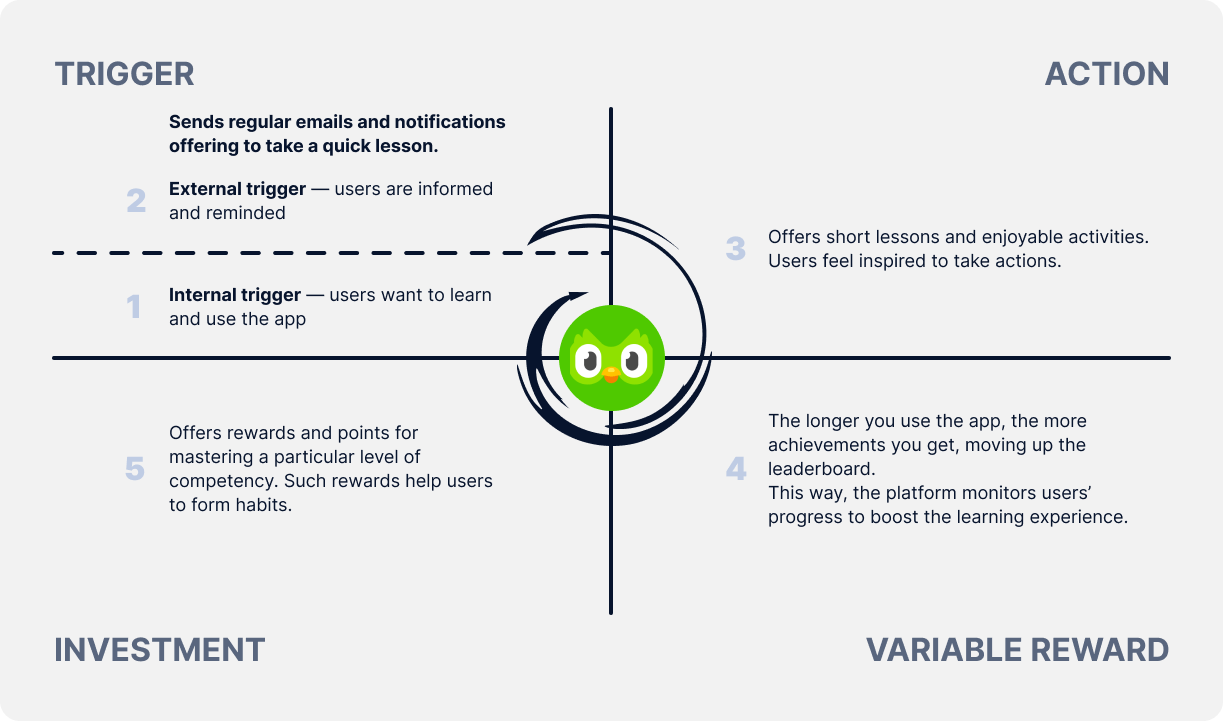
Reward Changes:
- Social Rewards: Duolingo is great at building its community of learners, which makes many users want to join. In addition, the app is also very clever in giving out compliments and honoring learners when they achieve certain achievements.
- Rewards for Effort: The curriculum is divided into milestones, and viewers will receive bonus points and titles after trying to complete each milestone.
- Rewards from Yourself: The feeling of satisfaction when you learn a new language, when you do well on a test after each lesson.
Invest:
Similar to Netflix, Duolingo also encourages users to invest time in learning by giving away the first hours of lessons for free, allowing learners to track their learning progress, dividing their learning progress into many milestones to encourage their spirit, etc. There are also achievement rankings that stimulate users’ competitive spirit. Duolingo also tracks users’ progress and allows them to challenge their friends, making the learning race more interesting and worth investing in.
With those features, users’ time investment in the app becomes larger and larger, and it becomes harder for them to leave the app.
Conclusion:
Habits always have a special power over consumer shopping behavior. Therefore, if the product can be integrated into the daily habits of consumers, the brand will win. The Hook model is a very useful tool for brands to do that. From triggering needs, stimulating actions, rewards after those actions and finally the time investment will make it difficult for users to leave the brand. And after many cycles like that, habits will be formed. However, to successfully apply the Hook model, it requires brands to have a thorough research from the emotions, pain or even the past of customers, and must continuously rotate the model, persevere with the above activities.
Comment Policy: We truly value your comments and appreciate the time you take to share your thoughts and feedback with us.
Note: Comments that are identified as spam or purely promotional will be removed.
To enhance your commenting experience, consider creating a Gravatar account. By adding an avatar and using the same e-mail here, your comments will feature a unique and recognizable avatar, making it easier for other members to identify you.
Please use a valid e-mail address so you can receive notifications when your comments receive replies.
